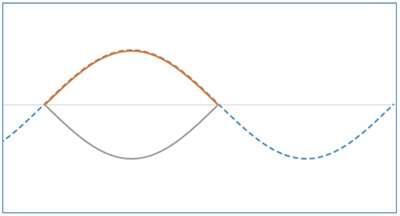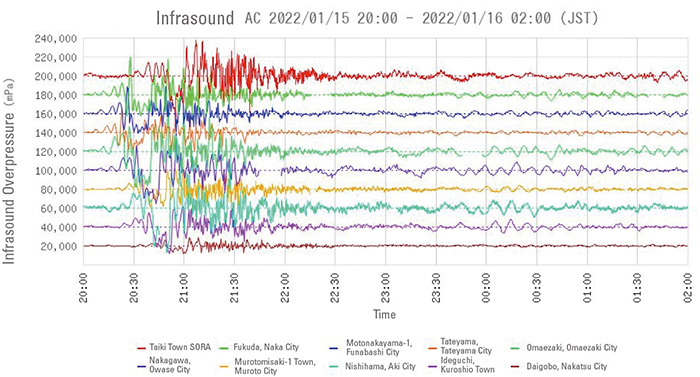Ocean Newsletter
No.540 February 5, 2023
-
Research on Linking Infrasound Monitoring with Tsunami Preparedness
YAMAMOTO Masa-yuki (Professor, School of Systems Engineering, Kochi University of Technology / Head, Infrasound Research Laboratory, Kochi University of Technology)
Earth’s natural phenomena, such as earthquakes and volcanic eruptions, generate infrasound (low-frequency sound) which cannot be detected by human ears. Since 2016, Kochi University of Technology has installed infrasound sensors – which they developed - at 31 locations between Hokkaido and Miyazaki Prefecture to monitor air vibrations. In January 2022, there was a massive eruption on a volcanic island in Tonga. Sea level fluctuations resulting from huge atmospheric pressure fluctuations were transmitted to the sensors at nearly the speed of sound, clearly showing that infrasound observation is effective for tsunami preparedness.
-
The “SDGs Native” Generation and Plastic Pollution
ASARI Misuzu (Associate Professor, Graduate School of Global Environment Studies, Kyoto University)
Today’s elementary, junior high, and high school students have been learning about social issues from a young age; one could say they are the “SDGs Native” generation. With a high level of knowledge and understanding regarding sustainability and SDGs, there have been impressive examples of their efforts and accomplishments related to measures against marine plastic pollution. On the other hand, it has been pointed out that there is a segment of the population that is indifferent. We think that it is important to hold various activities to encourage them to get personally invested.
-
Super Typhoons, Science, and Sailing Onboard Statsraad Lehmkuhl
Lucy DICKIE (Formerly Communication and Public Relations Division, OIST; Okinawa Institute of Science and Technology Graduate School)
Along with others from around the world, I recently had the opportunity to participate in the One Ocean Expedition voyage of the Norwegian tall ship, the Statsraad Lehmkuhl, as part of the UN Decade of Ocean Science initiative. The voyage allowed me to experience the importance of cooperation among the crew members, as well as to learn how the depth and vastness of ocean problems make them global in scale, requiring international cooperation for their solution.
Research on Linking Infrasound Monitoring with Tsunami Preparedness
[KEYWORDS] infrasound / tsunami disaster prevention / interdisciplinary scienceYAMAMOTO Masa-yuki
Professor, School of Systems Engineering, Kochi University of Technology / Head, Infrasound Research Laboratory, Kochi University of Technology
Earth’s natural phenomena, such as earthquakes and volcanic eruptions, generate infrasound (low-frequency sound) which cannot be detected by human ears. Since 2016, Kochi University of Technology has installed infrasound sensors – which they developed - at 31 locations between Hokkaido and Miyazaki Prefecture to monitor air vibrations. In January 2022, there was a massive eruption on a volcanic island in Tonga. Sea level fluctuations resulting from huge atmospheric pressure fluctuations were transmitted to the sensors at nearly the speed of sound, clearly showing that infrasound observation is effective for tsunami preparedness.
Earth’s Inaudible Low-Frequency Sounds
Have you ever heard the voices of the Earth? Our planet is a massive instrument: it constantly produces various audible and inaudible sounds whether humans realize it or not. Sounds such as wind, ocean rumblings, thunder, and volcanic eruptions contain audible components that can be heard if the location and timing are right. On the other hand, there are sounds with wave components below the lower limit of human perception known as infrasound (frequency of less than 20 Hz). Infrasound is generated, propagated, and attenuated in the Earth's atmosphere unnoticed, blending into the world. Sound waves are longitudinal waves (compression waves) transmitted by the vibration of air as a medium. In a string quartet, the violin, which has the shortest strings, produces high-pitched (high-frequency) sounds, while the contrabass, which has the longest strings, produces low-pitched (low-frequency) sounds. There are also huge instruments that produce inaudible sounds and no discernible music. European cathedrals which house pipe organs, for example, have resonated within the hearts of people for several hundred years, with the building itself forming a giant musical instrument that vibrates the space.
Now, envision an even grander instrument. Lightning, generating kilometer-scale plasma luminescence, acts as a giant string instrument that lasts only an instant. Volcanic eruptions serve as wind instruments due to the subterranean tubes beneath their craters, while avalanches and landslides form immense drums with shifting surfaces made of snow, ice, or debris. And the most fearsome and expansive source of sound on Earth emanates from sea level changes (uplift or subsidence) induced by massive underwater earthquakes that are manifested on the sea surface, giving rise to tsunamis.
Tsunamis Create Large-Scale Atmospheric Vibrations
Though it depends on temperature conditions, the speed of sound waves in the atmosphere is approximately 340 m/s, which equates to traveling 1 km in 3 seconds. Waves consist of peaks and troughs and can resonate with a spatial structure at a half-wavelength scale (half the length of one wave) (Figure 1). Thus, sound waves originating from a 170-meter structure produce air vibrations that oscillate at a frequency of 1 Hz per wave. The structure of a tsunami source extends over hundreds of kilometers in scale. If a 170-kilometer-diameter area of ocean suddenly rose, it would result in enormous atmospheric oscillations with a period of 1,000 seconds (approximately 16 minutes). Precision measurements necessitate specialized sensors that combine the advantages of both pressure gauges and microphones, as the former is too high-frequency and the latter is too low-frequency. Since 2004, Kochi University of Technology has been conducting basic research with students to develop these sensors.
On March 11, 2011, during the Great East Japan Earthquake, a precision barometer at the Mizusawa VLBI Observatory1 at the National Astronomical Observatory of Japan detected atmospheric vibrations caused by a tsunami. The signal was substantial enough to be identified with a barometer. Our team used this as an opportunity to begin full-scale development of a domestically produced comprehensive infrasound sensor in cooperation with a manufacturer, utilizing the results of its prior research, and the product was brought to market in 2015. Similar to how exploring new frequency bands in astronomy led to fresh discoveries, sensing infrasound is expected to unveil new frontiers in atmospheric science, disaster prevention, and mitigation engineering. Since 2016, sensors have been installed in 15 locations around Kochi University of Technology in Kochi Prefecture, thanks to a research grant from the SECOM Science and Technology Foundation. Currently, the sensors are operated at 31 locations from Hokkaido to Miyazaki Prefecture. To date, regional measurement data have been collected for various events, including the sounds of volcanic eruptions in Kyushu, chemical explosions in neighboring countries measured in the Shikoku region, direct hits from typhoons, thunder, fireballs (bright meteors), frontal passages, wind gusts, heavy rainfall, and rocket launches.
 ■ Figure 1: Resonance Mechanisms
■ Figure 1: Resonance Mechanisms
Ultra-low-frequency atmospheric sounds generate pushing (gray) and pulling (orange) forces on the ocean surface, creating resonant waves (blue dotted line). (c) Kochi University of Technology
A Once-in-a-Century Event "Voice of the Earth" and Meteotsunami from Tonga
On January 15, 2022, the observation network finally detected an immense nationwide signal. This “voice of the Earth” maintained nearly the same waveform from Hokkaido to Kyushu (Figure 2). Surprisingly, the source of these waves was a massive eruption at the volcanic island of Hunga Tonga-Hunga Ha'apai2 in the South Pacific, 8,000 km away from Japan. This marked the first such event recorded on earth with modern observational equipment. An unanticipated tsunami was also observed, leading the Japan Meteorological Agency to issue a late-night emergency press conference. The actual arrival time of the small tsunami, triggered by subsequent seafloor topographic changes due to the volcanic eruptions, was much earlier than expected. A maximum seawater level change of over 1 meter was detected at multiple locations along Japan's Pacific coast, causing fishing boats to capsize in a fishing port in Kochi Prefecture. When infrasound arrives, it can cause Japanese shoji screen doors to rattle. Similarly, the mysterious tsunami was presumed to be caused by pressure fluctuations traveling over the sea surface, stimulating the sea surface. The authors' infrasound and atmospheric pressure observations, along with the rapidly-developed seabed pressure observations following the Great East Japan Earthquake (S-net off the east coast of Japan and DONET-2 off the Kii Peninsula), provided consistent results.
This mysterious tsunami event is reminiscent of the famous Abiki3 (secondary undulations, meteotsunami) in Omura Bay, located in Nagasaki Prefecture. When a rapidly developing low-pressure system with an accompanying front moves swiftly over the East China Sea, where the seafloor topography has a flat continental shelf extending to a depth of around 200 meters, the eastward speed of the low-pressure system and the wave propagation speed in the continental shelf align, causing the atmosphere and sea to resonate. This creates vibrations on the sea surface that push towards the coast and cause further resonance (secondary undulations) in Omura Bay - which typically resembles a lake surface - resulting in storm surges damage. Could the Tonga eruption and the mysterious tsunami be considered a similar phenomenon on a massive scale? The enormous eruption of the Tonga volcano generated pressure fluctuations of an unprecedented scale at a single point over the Pacific Ocean, traveling across the sea surface like concentric ripples at nearly the speed of sound. Most of the submarine topography of the Pacific Ocean are on the ocean floor at a depth of 4,000 to 6,000 meters. The wave propagation speed in the ocean increases with depth, and it approaches the speed of sound in the deep ocean, resulting in excitation. This excited state is sustained over thousands of kilometers where the deep ocean floor extends. As the water depth decreases in coastal areas, the speed drops down and the following waves catch up, creating a clear threat due to the accumulation effect. A tidal station in the inner bay detected a fluctuation of approximately 1.3 meters. In reality, there are several physical classifications of pressure waves (with ultra-low-frequency sounds being a part of them), and the authors believe that a component called atmospheric gravity waves played a significant role in this event4.
 ■Figure 2: Infrasound waveforms observed from the Tonga volcanic eruption on January 15, 2022
■Figure 2: Infrasound waveforms observed from the Tonga volcanic eruption on January 15, 2022
Recommendations for Early Implementation of Infrasound Observation Networks
This event has showcased the value of establishing an infrasound observation network for tsunami disaster prevention in coastal nations worldwide. Land-based sensors offer cost advantages in deployment and maintenance, making them easily implementable even in developing countries. We advise the early installation of these sensors in Japan, at a density comparable to that of seismographs, AMeDAS weather stations, and GPS geodetic stations. Remarkably, the observed sea level fluctuations were also detected along the Caribbean Sea coastline, which is separated from the Pacific Ocean by land. In the case of large-scale events, it is crucial to reintegrate knowledge from modern science, which has been divided into multiple spheres, such as the atmosphere and ocean, within the field of geophysics. While it may appear to be a stretch, we would like to emphasize that if a 100-meter-scale asteroid (a large meteorite) were to fall from space into the solar system, pressure fluctuations could excite a meteotsunami, potentially impacting coastlines anywhere in the world. (End)
- 1VLBI stands for Very Long Baseline Interferometry, a technique for measuring the position of an antenna using radio waves from celestial objects.
- 2Yoshiyuki Tatsumi, “Lessons from the Tongan Undersea Volcanic Eruption for the Maritime and Volcanic Nation of Japan,” Ocean Newsletter, No. 522 (published May 5, 2022)
- 3Ryohei Okada, "The “Abiki” Secondary Undulation,” Ocean Newsletter, No. 218 (published September 5, 2009)
- 4Nishikawa, Y., M.-Y. Yamamoto, K. Nakajima, I. Hamama, H. Saito, Y. Kakinami, M. Yamada, T.-C. Ho, Observation and Simulation of Atmospheric Gravity Waves Exciting Subsequent Tsunami along the Coastline of Japan after Tonga Explosion Event, Scientific Reports, 12, 22354, 2022.
